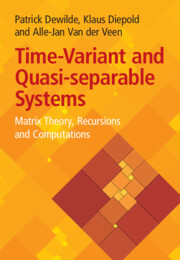2 results
3 - LTV (Quasi-separable) Systems
- from Part I - Lectures on Basics with Examples
-
- Book:
- Time-Variant and Quasi-separable Systems
- Published online:
- 24 October 2024
- Print publication:
- 31 October 2024, pp 41-58
-
- Chapter
- Export citation

Time-Variant and Quasi-separable Systems
- Matrix Theory, Recursions and Computations
-
- Published online:
- 24 October 2024
- Print publication:
- 31 October 2024

